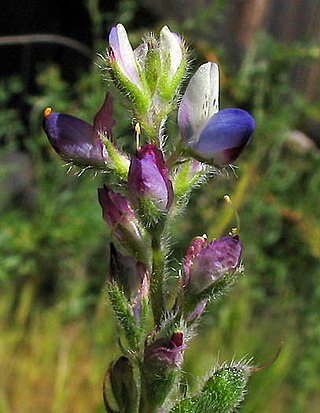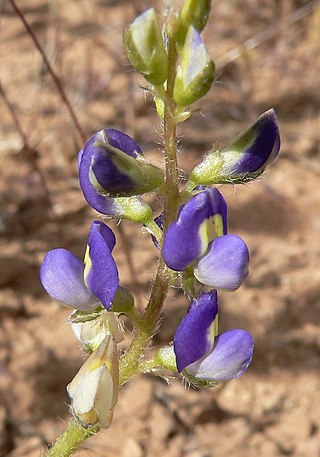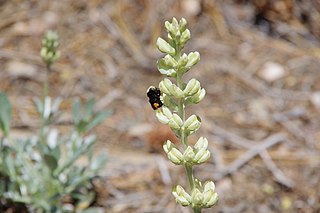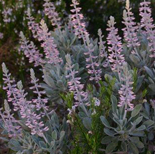Lupinus odoratus is a species of lupine known by the common name Mojave lupine. It is native to the Mojave Desert and adjacent western Great Basin in the United States, where it grows in sandy or gravelly soils in open habitat.

Lupinus succulentus is a species of lupine known by the common names hollowleaf annual lupine, arroyo lupine, and succulent lupine.
Lupinus andersonii is a species of lupine known by the common name Anderson's lupine.

Lupinus angustiflorus is a species of lupine known by the common name narrowflower lupine. It is endemic to California, where it grows in the volcanic soils of the northeastern mountains and Modoc Plateau. It is an erect perennial herb sometimes exceeding one meter in height. Each palmate leaf is made up of 6 to 9 leaflets each up to 6 centimeters long. The inflorescence is up to 34 centimeters long, bearing many flowers each of which is roughly a centimeter long. The flower is cream to pale yellow-orange with a patch of deeper yellow or orange on its banner. The keeled lower petals may be tipped with lavender. The fruit is a hairy legume pod up to 4 centimeters long.

Lupinus argenteus is a species of lupine known by the common name silvery lupine. It is native to much of western North America from the southwestern Canadian provinces to the southwestern and midwestern United States, where it grows in several types of habitats, including sagebrush, grassland, and forests. This is a perennial herb growing erect to heights anywhere between 10 centimetres (3.9 in) and 1.5 metres (4.9 ft). It is sometimes silvery-hairy in texture and sometimes nearly hairless. Each palmate leaf is made up of 5 to 9 leaflets each up to 6 centimetres long. They are narrow and linear in shape, under a centimetre wide. The inflorescence bears many flowers, sometimes arranged in whorls. The flower is 5 millimetres (0.20 in) to 14 millimetres (0.55 in) long and purple, blue, or whitish in color. The banner, or upper petal, of the flower may have a patch of white or yellow. The fruit is a hairy legume pod up to 3 centimeters long containing several beanlike seeds. The plant is an important food source for butterflies. It also attracts birds and hummingbirds.

Lupinus brevicaulis is a species of lupine known by the common names shortstem lupine and sand lupine. It is native to the southwestern United States and Great Basin area and into northern Mexico, where it grows in many types of sandy habitat. This is a hairy annual herb growing nearly flat in a spread on the ground with a stem just a few centimeters long. An array of leaves encircles the base. Each palmate leaf is made up of 6 to 8 leaflets about a centimeter long and a few millimeters in width. The inflorescence is a petite spiral of flowers a few centimeters long just arising past the basal disc of leaves. Each flower is 6 to 8 millimeters long and bright blue in color, generally with a white or yellowish spot on its banner. The fruit is a hairy legume pod about a centimeter long containing 1 or 2 beanlike seeds.

Lupinus concinnus is a species of lupine known by the common name Bajada lupine. It is native to the southwestern United States from California to Texas, and northern Mexico, where it is known from many types of habitat. This is a hairy erect or decumbent annual herb with a stem growing 10 to 30 centimeters long. Each small palmate leaf is made up of 5 to 9 leaflets up to 3 centimeters long and under a centimeter wide, sometimes narrow and linear in shape. The inflorescence is a dense spiral of flowers, with some flowers also appearing in leaf axils lower on the plant. Each flower is 5 to 12 millimeters long and purple, pink, or nearly white in color. The fruit is a hairy legume pod around a centimeter long.

Lupinus flavoculatus is a species of lupine known by the common name yelloweyes, or yellow-eyed lupine.

Lupinus luteolus is a species of lupine known by the common names pale yellow lupine and butter lupine. It is native to the coastal mountain ranges of Oregon and California as far south as the Transverse Ranges, where it grows in open habitat such as clearings and sometimes disturbed areas. It is an annual herb with a rigid stem growing to maximum heights anywhere between 30 centimeters and 1.5 meters, and known to exceed that at times. Each palmate leaf is made up of 7 to 9 hairy leaflets 1 to 3 centimeters long. The inflorescence is a raceme of crowded whorls of flowers each just over a centimeter long. The flower is often pale to bright yellow, but can be blue or pinkish. The fruit is a hairy, rounded or oval legume pod generally containing 2 seeds.
Lupinus nevadensis is a species of lupine known by the common name Nevada lupine. It is native to the western Great Basin in Nevada and adjacent sections of Oregon and California, where it grows in sagebrush and other typical basin habitat. It is an erect perennial herb growing 10 to 40 centimeters tall. Each palmate leaf is made up of 6 to 10 hairy leaflets up to 5 centimeters long. The stem and herbage are coated in long hairs. The inflorescence is a spiral of flowers each around 1 centimeter in length. The flower is blue with a whitish patch on its banner and a curved keel. The fruit is a very hairy legume pod up to 4 centimeters long.

Lupinus padre-crowleyi is a rare species of lupine known by the common names Father Crowley's lupine and DeDecker's lupine. It is endemic to California, where it is known only from the eastern slopes of the Sierra Nevada and the high plateau below along the western border of Inyo County. It grows in the granite soils of the mountain forests and scrub. It has been noted at fewer than 20 locations. This is a perennial herb growing an erect inflorescence from a mat of silvery, woolly-haired herbage, reaching maximum heights over half a meter. Each palmate leaf is made up of 6 to 9 leaflets up to 7.5 centimeters long. The inflorescence is a raceme of whorled flowers each just over a centimeter long. The flower is cream to pale brownish yellow in color. The fruit is a silky-haired legume pod containing black-mottled white seeds.

Lupinus peirsonii is a rare species of lupine known by the common names Peirson's lupine and long lupine. It is endemic to the San Gabriel Mountains of Los Angeles County, California, where it grows in woodland and forest habitat. It is an erect, branching perennial herb growing 30 to 60 centimeters tall. Each palmate leaf is made up of 5 to 8 fleshy leaflets up to 7 centimeters long. The herbage is coated in silvery silky hairs. The inflorescence is a raceme of whorled yellow flowers each about a centimeter in length. The fruit is a silky-haired legume pod 3 or 4 centimeters long.
Lupinus saxosus is a species of lupine known by the common name rock lupine. It is certainly native to eastern Washington, eastern Oregon, and the northeast corner of California,where it grows in sagebrush and other habitat. It may also be native to Idaho and Nevada.

Lupinus sericatus is a species of lupine known by the common name Cobb Mountain lupine. It is endemic to the North Coast Ranges of California north of the San Francisco Bay Area, where it grows in the forest, woodlands, and chaparral of the slopes and canyons. It easily colonizes disturbed habitat as well. This is a perennial herb growing up to half a meter tall. Each palmate leaf is made up of 4 to 7 distinctive wide spoon-shaped leaflets each 3 to 5 centimeters long. The inflorescence is a raceme of several whorls of purple flowers, each flower between 1 and 2 centimeters long. The fruit is a hairy legume pod 2 or 3 centimeters long.
Lupinus shockleyi is a species of lupine known by the common name purple desert lupine. It is native to the Mojave and Sonoran Deserts, where it grows in open desert habitat. It is an annual herb growing up to 30 centimeters tall. Each palmate leaf is made up of 8 to 10 leaflets measuring 1 to 3 centimeters in length. The inflorescence is a small spiral of flowers. Each flower is about half a centimeter long and deep purple-blue in color with a yellowish patch on its banner. The fruit is an oval legume pod coated in thick, inflated hairs.

Lupinus spectabilis is a species of lupine known by the common name shaggyhair lupine. It is endemic to a section of the central Sierra Nevada foothills in Mariposa and Tuolumne Counties, where it is a member of the serpentine soils flora.

Lupinus stiversii is a species of lupine known by the common names harlequin annual lupine and harlequin lupine. The plant was named for Army physician Dr. Charles Austin Stivers, who first collected it in 1862 near Yosemite.

Lupinus tidestromii is a rare species of lupine known by the common names clover lupine and Tidestrom's lupine. It is endemic to the coastline of California just to the north and south of the Golden Gate in Sonoma, Marin, and Monterey Counties. It is a plant of the sand dunes at separate beach locations in these counties. A very limited amount of this plant's habitat remains; it is a federally listed endangered species. Construction of golf courses on the Monterey Peninsula caused the extirpation of two known occurrences, and boardwalks were built at Asilomar State Beach to prevent trampling of the delicate dune habitat there.

Lupinus truncatus is a species of lupine known by the common name collared annual lupine.

Lupinus aridorum is a rare species of lupine known by the common name scrub lupine. It is endemic to Florida in the United States, where there were 10 known populations remaining in 2003. Fewer than 6000 individual plants were counted. It is threatened by the loss and degradation of its habitat. The scrub lupine is a federally listed endangered species of the United States.














